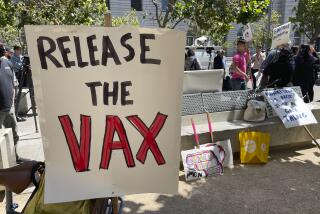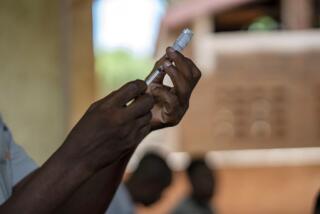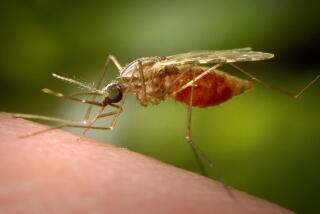Ebola vaccine tests on monkeys show promise
- Share via
Tests of an experimental Ebola vaccine have shown positive results, protecting healthy monkeys from contracting the virus, the National Institutes of Health announced Sunday, as West Africa grapples with the epidemic that has killed around 2,000.
Five weeks after giving them a shot of the experimental vaccine, called ChAd3, researchers exposed four macaque monkeys to high levels of the Ebola virus, and all the monkeys were protected, the NIH National Institute of Allergy and Infectious Diseases said.
The protection decreased over time, it said: Ten months after receiving a shot of the vaccine, two of four monkeys were protected.
Researchers also tried giving monkeys the experimental vaccine and then, eight weeks later, a booster vaccine. Ten months after the initial dose, all four monkeys were fully protected from being infected with Ebola, the institute said.
The authors of the latest study, published Sunday in the journal Nature Medicine, suggested that without the booster dose of vaccine, the Ebola virus can quickly regain a foothold and attack the immune system itself. The booster dose appears to generate an army of killer T cells that deny the virus that foothold.
Human safety trials of the ChAd3 vaccine were scheduled to start last week in Bethesda, Md., with preliminary results due by the end of 2014. In the current crisis, American officials overseeing the trials suggested that the availability of a tested vaccine will offer some crucial assurance of protection to healthcare workers wary of going to West Africa.
The experimental vaccine, developed by the pharmaceutical giant GlaxoSmithKline, contains no infectious Ebola virus material. It is a chimpanzee adenovirus vector vaccine into which two Ebola genes have been inserted. To deliver its genetic payload, the vaccine is designed to enter healthy cells on the back of a chimpanzee cold virus. The genes do not replicate themselves inside the cells, but prompt them to produce a protein to which the body makes an immune response.
The booster vaccine contains Ebola gene segments incorporated into a different vector: a poxvirus, the NIH said.
The research team that did the trials on macaques was led by Nancy J. Sullivan of the NIH and included scientists from Okairos, a biotechnology company that is now part of GlaxoSmithKline, and the U.S. Army Medical Research Institute of Infectious Diseases.
There is no cure or approved vaccine for Ebola, which is transmitted through contact with the bodily fluids of those infected.
A study published last month in the journal Nature raised hopes that experimental medication ZMapp might be an elixir of deliverance. Among 21 macaques infected with Ebola, all 18 who got three doses of ZMapp — including some who were days away from death — were able to clear the virus from their systems. The three animals that did not receive the drug died.
The response of macaque monkeys, both to vaccine candidates and to experimental treatments for Ebola, is thought to be a good predictor of human response, since Ebola virus behaves very similarly in macaques and in humans.
A total of seven Ebola patients have received ZMapp, but it is not known whether the drug aided their recovery. Five of them were later released from hospitals, including two Americans. The other two patients did not survive.
The company that developed the drug, Mapp Biopharmaceutical Inc., says it has no doses left.
The U.S. is seeking to speed up production of more ZMapp, but experts said it probably won’t be ready in time to help the tens of thousands of people likely to be infected by the Ebola virus in the coming months. The World Health Organization projects that as many as 20,000 may be infected with Ebola before the epidemic is brought under control.
Times staff writer Alexandra Zavis contributed to this report.
For news about science, health and more, follow @raablauren and @LATMelissaHealy on Twitter.








